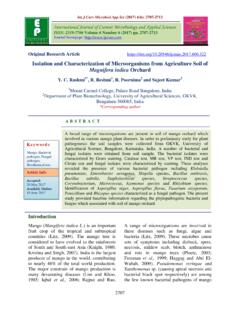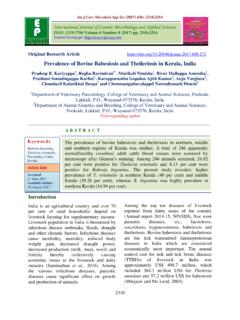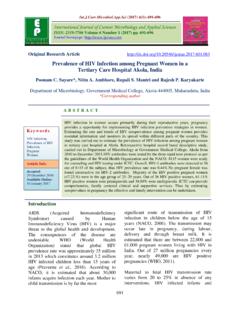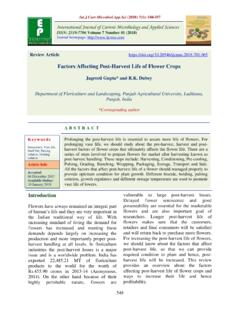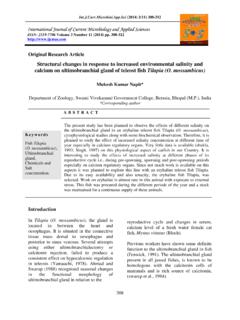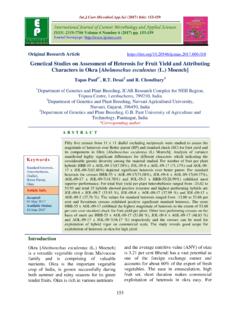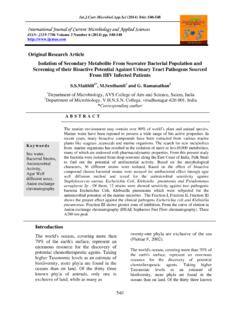Transcription of Evaluation of Different Varieties of Aerobic Rice …
1 (2017) 6(5): 2793-2801 2793 Original Research Article Evaluation of Different Varieties of Aerobic Rice (Oryza sativa L.) under Different Fertigation Levels on Growth and Yield Parameters M. Chandrika*, M. Uma Devi, V. Ramulu and M. Venkata Ramana Water Technology Centre, College of Agriculture, Professor Jayashankar Telangana State Agricultural University, Rajendranagar, Hyderabad - 500 030, India *Corresponding author: A B S T R A C T Introduction Rice (Oryza sativa L.) is one of the most important staple food crop in the world. Rice is the staple food in Asia but also the single biggest user of fresh water. The declining availability of water threatens the traditional way of irrigated rice production.
2 Further, Asia is considered to be RICE BOWL of the world and produces more calories and carbohydrates per hectare than any other cereals in India (Lu and Chang, 1980). An efficient use of water is essential to safeguard food security in Asia. Technologies like saturated soil culture and alternate wetting and drying are found promising but require prolonged periods of flooding. Aerobic rice, reduce water inputs in rice field by cutting down the unproductive water losses caused due to seepage and percolation. Experiments on Aerobic rice have shown that water inputs were more than 50 per cent lesser (only 470-650 mm) and water productivities were 64-88 per cent higher than the lowland rice, but require improved Varieties bred specifically for Aerobic condition.
3 International Journal of Current Microbiology and Applied Sciences ISSN: 2319-7706 Volume 6 Number 5 (2017) pp. 2793-2801 Journal homepage: A field experiment was conducted at Water Technology Centre, College farm, Rajendranagar, Hyderabad during kharif, 2015 to study the Response of Different Varieties of Aerobic rice (Oryza sativa l.) under drip fertigation levels. The experiment was conducted with three main treatments and four sub treatments. The main treatments were three rice Varieties (RNR 15048, MTU 1010 and Anagha) and the sub treatments were four Different fertigation levels (S0: Control, S75:90-45-30 kg N-P2O5-K2O ha-1, S100:120-60-40 kg N-P2O5-K2O ha-1, S125:150-75-50- N-P2O5-K2O ha-1. Drip irrigation was scheduled once in 3 days based on daily data of USWB class A pan evaporimeter at Epan.)
4 The amount of total irrigation water used including effective rain fall (277 mm) for Different Varieties were Anagha (9720 m3), MTU 1010 (9910 m3) and RNR 15048 (10110 m3) through drip irrigation. The differences in amount of water used were Different for Different Varieties due to the differences in their crop growth period. The crop growth period noticed was 131, 139 and 151 days for Anagha, MTU 1010 and RNR 15048 respectively. The data on grain yield, straw yield, growth parameters, dry matter production, were recorded at Different growth stages. K e y w o r d s Aerobic rice, Drip fertigation, Pan evaporimeter, Effective rainfall Accepted: 26 April 2017 Available Online: 11 May 2017 Article Info (2017) 6(5): 2793-2801 2794 Materials and Methods A field experiment was conducted at Water Technology Centre, College farm, Rajendranagar, Hyderabad during kharif, 2015 to study the response of Different Varieties of Aerobic rice (Oryza sativa l.)
5 Under drip fertigation levels. The experiment was conducted with three main treatments and four sub treatments. The main treatments were three rice Varieties (RNR 15048, MTU 1010 and Anagha) and the sub treatments were four Different fertigation levels (S0: Control, S75:90-45-30 kg N-P2O5-K2O ha-1, S100:120-60-40 kg N-P2O5-K2 Oha-1, S125: 150-75-50- N-P2O5-K2O ha-1). The experimental soil was sandy clay loam in texture, slightly alkaline in reaction, non-saline, low in organic carbon and available nitrogen, medium in available phosphorous and high in available potassium. The mean weekly maximum (RH-II) and minimum relative humidity (RH-I during the crop growing period varied from) 73 to % and to % respectively, during kharif, 2015 and mm of rainfall was received in 26 rainy days.
6 The mean bright sunshine hours per day varied from to The average wind speed varied from to km h-1 in 2015. With respect to pan evaporation, mean pan evaporation ranged to mm day-1 in 2015. The seasonal cumulative pan evaporation during the crop period of kharif, 2015 was mm. Out of the Varieties chosen, RNR 15048 is recently released by as Telangana Sona and is gaining wider popularity among farming community. Hence there is a need to generate the data on this new variety in Different management practices. Hence this variety was included. The other variety MTU 1010 is a widely accepted, cold tolerant, bold seeded variety in both Telangana and Andhra Pradesh state and was found to perform better under Aerobic conditions than other popular Varieties .
7 Hence this variety was included under the study. The third variety Anagha is a variety specially released for growing under Aerobic conditions by , Bangalore. To test its suitability under Telangana, this variety was also included under the present study. The data grain yield and straw yield were collected and water productivity was computed. Results and Discussion Data on growth parameters like plant height, no. of tillers m-2, days to 50% flowering and dry matter production are presented in Table 1, Table 2, Table 3 and Table 4. It is significantly influenced by the Varieties , fertigation levels but not by their interaction. The plant height of Aerobic rice ranged from to cm, to cm, to cm and cm to cm in 30, 60, 90 DAS and at harvest respectively.
8 Among all Varieties , Anagha has recorded significantly, the highest plant height at all stages except 30 DAS followed by RNR 15048 and MTU 1010. The S125 has recorded the highest plant height at all the growth stages studied followed by S75, S100 and S0 respectively. Among the interactions, Anagha at S125 has recorded the highest plant height followed by Anagha at S100 in all the stages except at 30 DAS. Significantly, the lowest plant height has recorded in MTU 1010 at S0. Plant height is a function of genetic as well as environmental conditions (Abid Khan et al., 2014). Increased levels of irrigation regime through drip system with fertigation favoured plant height positively were reported by Govindan and Myrtel Grace (2012).
9 The no. of tillers m-2 ranged from 186 to 272, 191 to 290, 204 to 300 and 171 to 257 at 30, (2017) 6(5): 2793-2801 2795 60, 90 DAS and at harvest respectively. There was a constant increase in the no. of tillers m-2up to 90 DAS, but afterwards reduction was noticed by final harvest due to mortality of some tillers. Anagha at S125 has recorded significantly the highest no. of tillers m-2 followed by the same variety at S100at all the stages. Significantly the lowest no. of tillers m-2was recorded in MTU 1010 at S0 in all the stages except at 30 DAS. The S75, S100 and S100 have recorded , , higher no. of tillers m-2respectively over S0. Relatively lower number of tillers under Aerobic cultivation, when compared to transplanted rice was reported by Patel et al.
10 , (2010). Greater tiller mortality as a result of water deficit and iron deficiency might be the reason for lower tiller number in case of the Aerobic rice. Higher number of tillers with N180P90K60 + FeSO4 was reported by Rakesh et al., (2012). Bouman and Tuong (2001) stated that when rice is subjected to moisture stress, leads to lower no. of tillering. Similar results were expressed by Govindan and Myrtle Grace (2012). The leaf area index (LAI) ranged from to , to , to and to at 30, 60, 90 DAS and at harvest respectively. Among all the Varieties , Anagha recorded significantly the highest leaf area index followed by MTU 1010 and RNR 15048 at all the stages except at 60 DAS. The S125 recorded significantly, the highest leaf area index followed by S100, S75 and S0at all the stages.
